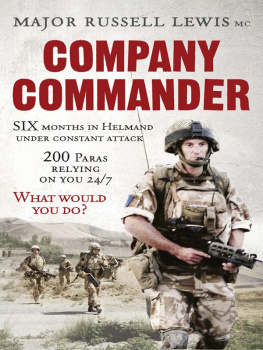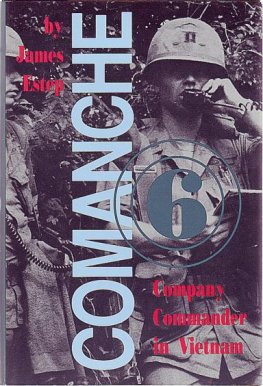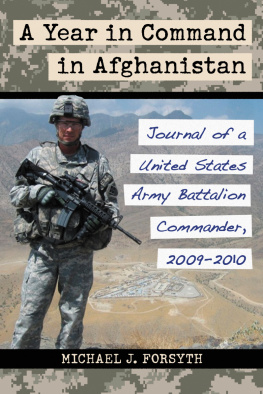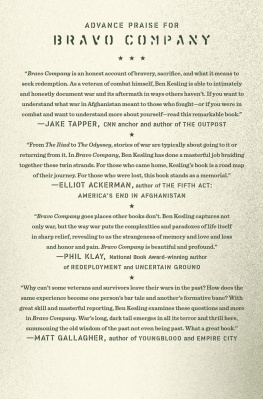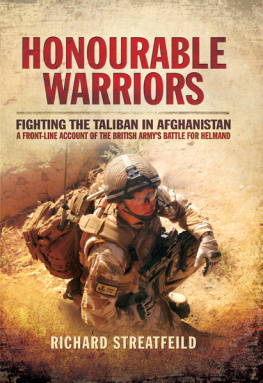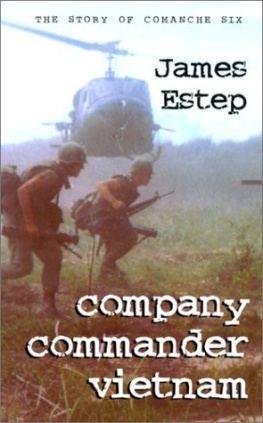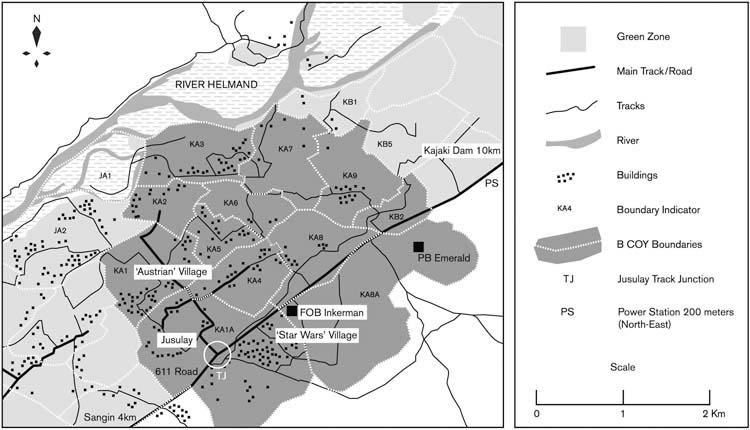CONTENTS
LIST OF MAPS
CONTACT MAPS
SANGIN AREA WITHIN HELMAND PROVINCE
B COMPANY, 2 PARA AREA OF OPERATIONS
COMPANY
COMMANDER
MAJOR RUSSELL LEWIS MC
This book is dedicated to all those that I have had the honour to command and fight alongside. It is particularly dedicated to those who paid the ultimate price. They remain forever in our hearts.
2 PARA Battle Group Roll of Honour Afghanistan 2008
2nd Battalion, The Parachute Regiment
Private Daniel Gamble
Private Dave Murray
Private Nathan Cuthbertson
Lance Corporal James Bateman
Private Jeff Doherty
Warrant Officer Class 2 Michael Williams
Private Joe Whittaker
Corporal Jason Barnes REME
Private Peter Cowton
Private Jason Rawstron
Corporal Nicky Mason
2 PARA Battle Group
Trooper Robert Pearson QRL (ASG)
Marine Dale Gostick ASC RM
Lance Corporal Kenneth Rowe RAVC and Sasha
Ranger Justin Cupples 1 RIRISH
In 2 PARA Battle Group Area of Operations
Warrant Officer Class 2 Daniel Shirley APTC
(ex 2 PARA)
Corporal Anthony Mihalo USMC
Lance Corporal Juan Lopez Castaneda USMC
Lance Corporal Jacob J. Toves USMC
In Memoriam
Sergeant Phil Train
Corporal Gareth Gwyther
AUTHORS NOTE
I HAD WANTED to join the army from a very early age. My grandparents took me to the Royal Tournament when I was four and from that point I was hooked. By the age of 13 I was obsessed and, by headmasters decree, was allowed to join my schools cadet force a year early. When I was 14 I read an incredible book called 2 PARA Falklands by John Frost. I remember thinking what incredible men these were. Outnumbered, poorly resourced and in horrendous conditions, these men fought not one, but two battles. I never believed, in my wildest imagination, that I would end up commanding, in battle, men like these.
At the age of 19 my dream came true when I passed the selection board to become a British Army officer. It was while at Sandhurst I decided I wanted to join the Parachute Regiment. They appeared to be the best regiment in the infantry. They had be they are the only ones with their own physical selection.
I commissioned in 1994. The physical selection for the Airborne forces P Company was as brutal as I expected it to be. After parachute training I joined 2 PARA in Northern Ireland. I found it incredible to be joining the organisation that I had read about in John Frosts book; what was even more incredible was the fact that there were still Falkland veterans in the battalion. I even had one in my platoon. I learnt a lot.
My career progressed steadily. I trained recruits and while doing this superb job I met my future wife, Andrea, an officer in the Queen Alexandras Royal Army Nursing Corps, who was training medical recruits at the same time. I became 3 PARAs mortar officer and was a company second-in-command for tours to Kosovo and Northern Ireland. I returned to 2 PARA as the surveillance officer for another Northern Ireland tour and then became the battalions operations officer before being selected for promotion to major. All I now wanted was to be a company commander in a PARA battalion.
I attended staff training and worked in defence procurement, buying small arms, ammunition and surveillance systems for the army. It was during this period that the regimental boards sat to decide who would go where. As ever, there were more people than available company command places and I sweated for a few months waiting to hear my fate. Late in 2006 I received the news I was to return to 2 PARA as Rifle Company Commander. My dreams had come true. Not only was I returning to the battalion I had spent the most time with, but I would also be going on operations. 2 PARA was chalked in to deploy to Afghanistan in April 2008.
PROLOGUE
Sir sir are you awake? The voice of one of my signallers drags me from my sleep. 0300 hours is never a nice time to get up. I am amazed at how well I manage to sleep with all that is tumbling around in my mind. I am conscious that within four hours I will probably be in a huge contact.
Private Crisp checks I am awake before heading back to the operations room. The signaller tasked with waking me up invariably brings me a cup of tea, which is always a welcome treat at such a horrendous time in the morning. I roll out of my camp cot, have a slurp of tea and head in to the storage room where I keep all of my kit. By midway through the tour it is too hot to sleep inside; the temperatures are hitting 45C by day and 28C at night, so a lot of us have moved our travel cots outside. You still sweat and ingest a lot of dust but sleeping inside is even worse it feels like being in a sauna.
Company headquarters all sleep in the briefing area, near the ops room. Next to the briefing area are a couple of mud buildings that formed the original compound out of which morphed the forward operating base (FOB). I share one room with my two sergeant majors and we keep our kit stacked up in there.
As I glance around there is activity in most directions as people prepare themselves and their kit for patrol. To protect our night vision we keep the lights off and work on head torches. This means that each soldier is working in his own little glow, cocooned from reality for a few more minutes.
I have another sip of tea and then start the laborious process of getting it on. Like a time-honoured ritual of the samurai or a Teutonic knight, we all have rituals and sequences that allow us to get our armour on. Trousers and boots first the boots are always a challenge. As we wade through drainage ditches and streams when on patrol, boots always get wet. They then dry far too quickly, so they shrink. This means that you have to stamp and kick your way in to them and enjoy a couple of minutes of one-size-too-small before they stretch back. Next, my undershirt goes on.
I leave putting on my body armour until the last moment so, once dressed, I go through my kit check. Rifle and pistol as dust free as possible. Radio and night-vision goggles fresh batteries and quick check to see that they are actually working. Magazine and grenades all in the correct place and then water bottles, all topped up. Once I am happy with my kit, it is just a matter of waiting. We have to carry a crippling load. The body armour alone weighs more than 13 kilos. Once you add ammunition, water, radio, night-vision goggles and spare batteries it is between 30 and 40kgs; not great to carry around the green zone in 40C heat. Yet my load is probably at the lower end of the spectrum; the lads will be carrying a lot more ammunition than me, so many of their loads will be pushing 45kgs. One thing we are not is agile! This becomes an issue when you are fighting an opponent who is wearing loose clothing, flip-flops and carrying an AK-47.
Invariably, I sit on my own before going on patrol. Some people seek the comfort of others, I like to sit quietly and gather my thoughts. We are all thinking and feeling the same, though. A mixture of pre-game nerves and anticipation. Deep down we dont really want to get hurt but we know there is a distinct possibility. By midway through our tour we have all been in contact and have all seen the horrors of friends and colleagues being injured and killed. As paratroopers, we like to think that we are tough but we have also seen the fragility of the human body when faced with modern high-velocity weapons. As the commander I take my mind off these thoughts and think through todays tactical plan. I try to identify any friction points an officers technical term for spotting the parts of the plan that could go wrong.
Next page
